

Berkeley Lab@75: A Time to Reflect and Celebrate
From A Small Wooden Building to a National Laboratory
Berkeley Lab@75: A Time to Reflect and Celebrate
With a distinguished history of world-changing discoveries and Nobel Prizes, plus the public support that has driven its annual budget beyond half a billion dollars, Berkeley Lab has endured as the Department of Energy’s oldest — and some say greatest — scientific research facility.

For the next 12 months, the Laboratory will be celebrating this milestone and its 75 years of achievement. Recognition will come in a variety of forms — the written word, including a monthly retrospective in The View that begins today; special events for Lab employees and the neighboring community; lectures and historic exhibits; and a day-long commemoration of Berkeley Lab’s founding on Saturday, Aug. 26 — the day three-quarters of a century ago when, in 1931, physicist Ernest Orlando Lawrence received official sanction for his “radiation laboratory.”
The Lab’s Creative Services Office has designed a special anniversary logo for use throughout the year on publications, stationery and displays. An anniversary web site will include features and a complete listing of events and activities as they are announced.
This year’s annual Summer Lecture Series will be devoted to recollections of days past, some by those who lived it and helped shape the Lab’s legacy. Similarly, a series of “Friends of Science” talks will be promoted for off-site community members to learn more about this unique resource that has been such a mystery to some over the years.
“An occasion like this gives us the opportunity to thank the public, whose taxes support our work, and our employees, whose contributions are legendary,” said David McGraw, the Lab’s Chief Operations Officer. “Recognition of our historic and current achievements brings pride to our institution and reminds everyone of the critical role that science plays in ensuring our nation’s prosperity.”
Ideas being explored as 75th anniversary events include a Lab “family day,” a “Back to the ‘30s” Founders Day, an anniversary gala dinner, a film festival, and sale of commemorative clothing and gift items. These and other plans will be announced as they develop.
From A Small Wooden Building to a National Laboratory
A Legacy of Achievement: the 1930's

The first cyclotron.
It was 75 years ago that a young physicist on the Berkeley campus of the University of California, Ernest Orlando Lawrence, founded a laboratory that would eventually bear his name. For 75 years the Lawrence Berkeley National Laboratory as it is now known, or Berkeley Lab for short, has continued to make scientific history. Ten Nobel Laureates have called Berkeley Lab their home institute. A dozen Berkeley Lab scientists have won the National Medal of Science. Behind these and countless other awards and honors has been a wealth of scientific discoveries and technological breakthroughs that have made enormous contributions to the knowledge-base of humanity.
From finding the antiproton, to deciphering the photosynthetic process, to unraveling the mystery behind the extinction of the dinosaurs, the list of accomplishments by Berkeley Lab scientists runs both wide and deep. Equally important, the unique approach to research, in which tough questions are tackled by interdisciplinary teams of scientists, engineers and support staff, which has been the tradition of Lawrence and his laboratory, became the foundation for the modern concept of Big Science.
It has often been said that to know where you are going, you must know where you’ve been. In honor of the 75th anniversary, the Berkeley Lab View will take a look back at our institute’s glorious history. Starting with this issue, we begin a 12-part series that will trace the Laboratory’s evolution from a small physics research group housed inside an old two-story, clapboard-sided, wooden building on the UC Berkeley campus, to a multi-program, multidisciplinary U.S. Department of Energy national laboratory sprawled across 200 acres in the hills overlooking the campus, with an annual budget of nearly half a billion dollars.
THE RAD LAB
Historians cite the Roaring Twenties as the decade in which the United States began its transition into a modern technology-based society. For the first time in the nation’s history, a majority of its citizens lived in urban areas. The Golden Age of radio broadcasting began; automobiles, telephones, and electric appliances became staples. The stock market soared and crashed. Prohibition came and went. Suffrage came and stayed. Politicians gave us isolationism, preachers gave us revivalism, and bootleggers brought us organized crime.
It was a period of momentous individual achievement and the emergence of new leaders who forever changed the way things had been done. Charles Lindbergh’s solo flight across the Atlantic ushered in the age of modern aviation; Babe Ruth’s home run heroics made baseball the national pastime; and Henry Ford’s assembly lines opened the doors to mass production. In the arts, the literature of Scott Fitzgerald and Ernest Hemingway, the music of George Gershwin, the humor of Charlie Chaplin, and the paintings of Edward Hopper showed the way with their enduring brilliance. And in the arcane world of science, a 27-year-old physics professor in Berkeley began the work that would launch the modern era of multidisciplinary national laboratories. His name was Ernest Orlando Lawrence.
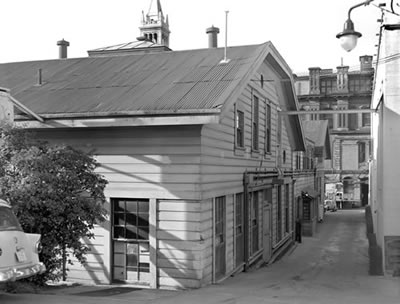
The old radiation Laboratory on the UC Campus.
Ernest Lawrence arrived at the University of California’s Berkeley campus in the summer of 1928, having been wooed from a faculty position with Yale University by promises that included auxiliary connections to the chemistry department. Until then, the traditional practice of science was that physicists, chemists, and biologists worked within their own departments and seldom ventured outside their disciplines. Access to scientists and students from other disciplines, as well as to engineering staff, was critical to Lawrence’s success as a researcher. It also set the pattern for the unique laboratory he created.
Inspired by a paper from Norwegian engineer Rolf Wideroe, Lawrence, early in 1929, drew up plans for a unique circular particle accelerator, which he referred to as his “proton merry-go-round,” but which would later become known as the cyclotron. It would be another year before Lawrence’s invention was actually made into a device. The first crude cyclotron was constructed in the spring of 1930 by Lawrence and his student, Nels Edlefsen. It was a pie-shaped concoction of glass, sealing wax and bronze. A kitchen chair and a wire-coiled clothes tree were also enlisted to make the device work. Despite its Rube Goldberg appearance, the cyclotron proved Lawrence’s point: whirling particles around to boost their energies, then casting them toward a target like stones from a slingshot could be an efficient and effective way to smash open atomic nuclei.
The first working model of a cyclotron came later that fall with the help of another Lawrence student, M. Stanley Livingston. The accelerating chamber of this cyclotron measured 5 inches in diameter and on January 2, 1931, it was successfully used to boost hydrogen ions (protons) to an energy of 80,000 electron volts. Immediately, Lawrence instructed Livingston and another student, David Sloan, to begin construction on an 11-inch cyclotron, a machine that would go on to break the one million electron volt (MeV) barrier. However, even as Livingston and Sloan were starting this project, Lawrence was dreaming of bigger things.
In his first year at Berkeley, Lawrence had developed close relationships with two UC Berkeley professors outside of the physics department, chemist Gilbert Lewis and electrical engineer Leonard Fuller. From Lewis he would later get deuterons, the hydrogen isotope in heavy water that proved an invaluable “stone” for smashing atoms. Fuller, who was also vice-president of the Federal Telegraph Company, helped Lawrence obtain an 80-ton magnet that had originally been built to power a transatlantic radio link in World War I but was now surplus. With the gift from Federal Telegraph, and deuterons to use as projectiles, the construction of a cyclotron with an accelerating chamber 27 inches in diameter, capable of reaching energies of nearly 5 MeV, had been made possible. Lawrence, however, would need more laboratory space, one with an exceptionally firm floor.
UC Berkeley had opened Le Conte Hall in 1924 as one of the largest physics buildings in the world. The goal was to build a physics department equal in stature to the University’s celebrated chemistry department. As part of that build-up, Lawrence had been lured away from Yale University and brought to Berkeley in 1928. One of the principals behind Lawrence’s recruitment was Robert Gordon Sproul, secretary to the UC Board of Regents and protégé of master university builder Benjamin Ide Wheeler. Sproul was betting that Lawrence would become one of the nation’s top physicists. He showed his faith in the fall of 1930 when, one day before his formal inauguration as the 11th UC president, he signed off on Lawrence, then 29, becoming the youngest man ever to be named a full professor on the Berkeley faculty.
Lawrence had been working out of Room 329 in Le Conte Hall, which was large enough to accommodate the 11-inch cyclotron, but not the 27-inch cyclotron, with its 80-ton magnet. After being refused space by the engineering faculty in the Mining Building, Lawrence turned to the new UC President and, once again, Sproul came through. On August 26, 1931, he committed to Lawrence the Civil Engineering Testing Laboratory, an empty building adjacent to Le Conte Hall which featured substantial concrete flooring, strong enough to support an 80-ton magnet. Lawrence renamed this building the “Radiation Laboratory,” but, in short time, it became known as simply as “the Rad Lab.”
LAWRENCE’S BOYS
The 1930s will forever be remembered in this country for the Great Depression, when the land of opportunity became the land of despair. Between 1930 and 1932, nearly half of the nation’s banks failed, Hooverville shanties sprang up across the land to shelter the thousands who’d lost their homes, and the farmlands of the Great Plains were transformed into a “Dust Bowl.” The election of Franklin Roosevelt as president in 1932, with his New Deal programs and Fireside Chats, began turning things around, but the climb back to prosperity would be difficult. Despite the adversity, there were notable triumphs. Two African American athletes, boxer Joe Louis and track star Jesse Owens, lifted the nation’s spirits with their transcendent skills. Will Rogers and Walter Winchell reached millions of radio listeners, the movie Gone with the Wind smashed box office records, the Empire State Building and Mount Rushmore were completed, Richard Byrd explored Antarctica, Frances Perkins became the first woman to serve on a President’s cabinet, and out on the West Coast, the boyish-looking director of UC Berkeley’s Rad Lab assembled a team of scientists and engineers whose accomplishments would become legendary.
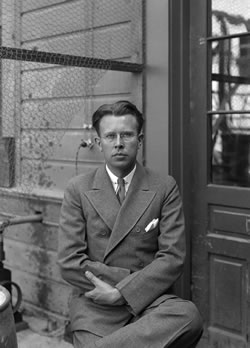
Ernest Lawrence circa 1930.
It took a year to get the 27-inch cyclotron up and running in the Rad Lab, but by September 1932 the machine was accelerating protons to 3.6 million electron volts. The centerpiece of the new Rad Lab would not enjoy its celebrity for long. Lawrence, always eager to advance to the next level, and somehow able to obtain funding despite the scarcity of money, laid plans to expand its accelerating chamber and make other modifications that resulted in a new 37-inch cyclotron, which, by 1937, could accelerate deut-erons to 8 MeV and alpha particles to 16 MeV. This machine was used to create radio-isotopes and the first artificial element, technetium.
The design, construction, and operation of increasingly larger cyclotrons required an increasingly larger number of physicists, engineers, and chemists. Lawrence’s personal charisma, unbridled enthusiasm and almost uncanny ability to procure financial donations from private sources, enabled him to recruit the best and the brightest. During the decade, the Rad Lab staff grew from five to 60 members. These members included Edwin McMillan, Luis Alvarez, Glenn Seaborg and Emilio Segrè, all of whom would go on to be Nobel laureates, plus other notables, such as Martin Kamen, J.J. Livingood, Philip Abelson, Felix Bloch and the peerless instrument maker Donald Cooksey. One of the most valuable of all his recruits came from Hollywood, mechanical engineer William Brobeck.
Lawrence’s scientific recruits proudly called themselves “Lawrence’s boys,” and they were evenly divided between physicists and chemists. Throughout the early years of the Rad Lab, Lawrence was never quite certain as to whether the research there should be called nuclear physics or nuclear chemistry. In recognition of this departure from the traditional academic lines of departmental science, the University on July 1, 1936 officially established the Radiation Laboratory as an independent entity within the Physics Department. Henceforth, the new laboratory would be dedicated to pursuits of “nuclear science” rather than physics or chemistry.
Lawrence, however, was not content to limit Rad Lab research to just two major disciplines. In 1935, he invited his brother John, a physician, to join the Lab and explore the use of cyclotron-produced radioisotopes in biology and medical research. Other physicians, like Joseph Hamilton and Paul Aebersold, soon followed.
The addition of physicians and biologists into the Rad Lab’s scientific mix led to the construction of a second building adjacent to the Rad Lab. Named the Crocker Radiation Laboratory after UC Regent William Crocker who donated the money for its construction, this new facility was designed to house a cyclotron with an accelerating chamber that measured 60 inches in diameter and a magnet that weighed 220 tons. The use of this machine by John Lawrence and his fellow physicians gave rise to modern nuclear medicine.
The 60-inch cyclotron began operations in 1939, the year that UC President Sproul’s gamble on Lawrence was fully realized. For his invention of the cyclotron, Lawrence won the 1939 Nobel Prize in Physics. The end of the decade would mark the end of the era of new Lawrence cyclotrons on the UC Berkeley campus. For the next machine he envisioned, a giant more than double the size of the 60-inch cyclotron, Lawrence would have to relocate his laboratory.
Next: Moving up the Hill

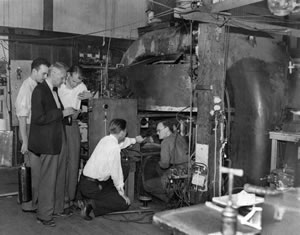
Left: The Lab blackboard announced Lawrence's Nobel Prize. Right: F. Kurie, Donald Cooksey, Edward McMillan, Ernest O. Lawrence, and Robert Thornton encouraging a beam in the 27-inch cyclotron.
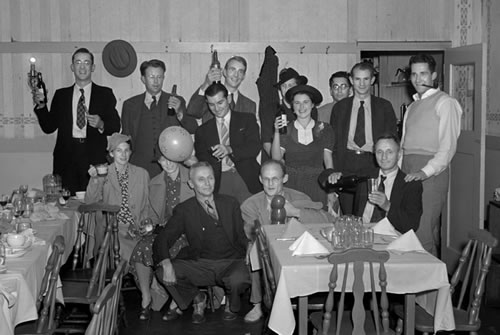
Above: Rad Lab camaraderie found a social outlet at Di Biasi's restaurant in Albany. Back row, left to right, standing: Bob Cornog, Ernest Lawrence, Luis Alvarez, Molly Lawrence, Emilio Segre; second row: Jerry Alvarez (seated), Betty Thornton, Paul Aebersold (standing), Iva Dee Hiatt, Edwin McMillan, Bill Farley; first row: Donald Cooksey, Robert Thornton, and one unidentified celebrant.
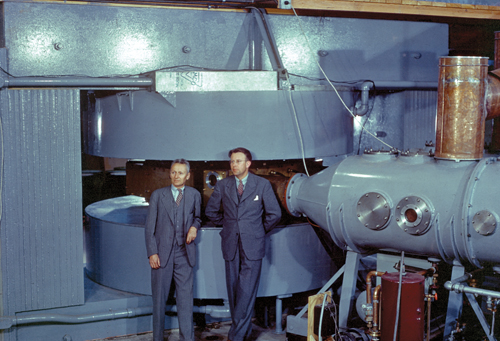
Above: Donald Cooksey and Ernest Lawrence at the 60-inch cyclotron in the Crocker Laboratory.
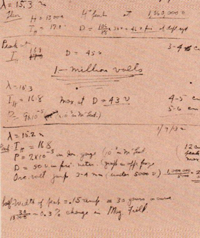

Left: Notebook entry of the first MeV reading: January 8, 1932, 11-inch cyclotron. Right: The 11-inch cyclotron, shown installed in Room 329 Le Conte Hall, the first cyclotron to exceed 1 MeV.
A Comet Comes to the Advanced Light Source
The Advanced Light Source is playing a key role in studying interstellar dust and bits of comet brought to Earth by the STARDUST mission, which parachuted its payload onto the Utah desert in the early morning hours of Sunday, January 15. Opened at NASA’s Johnson Space Center in Houston on Tuesday, the capsule’s contents proved to be in excellent condition.
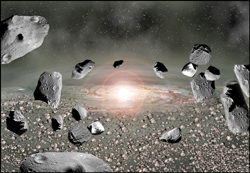
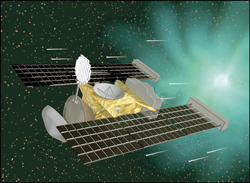
Left: The building blocks of planets and asteroids condensed from cold molecular clouds, preserving a record of their chemistry. Right: One side of a panel of aerogels mounted on STARDUST collected samples of ejecta during a fly-by of comet Wild 2 in January, 2004; the other side of the panel, oriented away from the comet, was used to pick up interstellar dust grains.
Some of the first analyses will be performed by ALS users from the Carnegie Institution of Washington, the Space Sciences Laboratory, and Lawrence Livermore National Lab-oratory, who will deploy the unique capabilities of infrared microspectroscopy beamline 1.4.3 and beamline 5.3.2’s scanning transmission x-ray microscope (STXM).
“The STARDUST principal investigator, Donald Brownlee of the University of Washington, set up preliminary examination teams for initial characterization of the returned samples,” says physicist Sa˘sa Bajt of Lawrence Livermore. Bajt’s team will perform nondestructive infrared spectroscopy measurements to answer some fundamental science questions about the nature of particles. “We will be able to directly compare our results to astronomical observations of grains in space.”
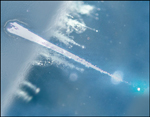
Comet ejecta and particles of dust were quickly but gently brought to a halt after slamming into aerogel tiles at up to six kilometers per second.
Bajt and her colleagues have worked with beamline 1.4’s manager Michael Martin on sample-preparation techniques and detection sensitivity. They practiced with interplanetary dust grains collected by Brownlee with high-flying U2s and samples collected by cosmonauts aboard the Mir space station.
Geochemist George Cody of the Carnegie Institution of Washington belongs to another of the preliminary examining teams, concentrating on the chemical evolution of the solar system, especially the organic compounds found in primitive meteorites. To develop a baseline, Cody has used beamline 5.3.2’s STXM. “There will be a lot of microscopes in play,” Cody says, “but this one will get the most information out fast.”
Beamline 5.3.2 is directed by the ALS’s David Kilcoyne, who reports that over the past year and a half it has yielded definitive measurements of more than two dozen meteorites as a reference for all future measurements of meteorites, interstellar dust grains, and pieces of comet. Cody and Kilcoyne work closely with astrophysicist Andrew Westphal and analytical chemist Anna Butterworth of the Space Sciences Laboratory.
“No one has knowingly sampled a comet before,” says Butterworth. “STARDUST will tell us what comets are made of. As for interstellar dust grains,” she adds, “STARDUST will give us the first-ever contemporary dust grains” — unaltered since they condensed from the cold molecular clouds that existed long before there was a planet Earth or anyone living on it to study what Hoagy Carmichael called “the stardust of yesterday.”
An inside look at one of the Lab�s many interesting employees�
Joe Harkin
Job
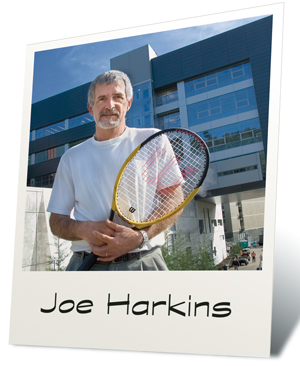
Molecular Foundry project manager; B51, Bevatron Demolition Project Director
Childhood Ambition
To be a priest
Weirdest Job
Earthquake damage reconnaissance in Mexico in 1984
Guilty Pleasure
Good wine
Hero
Lance Armstrong
Proudest Moment
Birth of first daughter
Last Book Read
Michael Crichton’s “State of Fear”
Current Tunes on iPod or CD Player
Coldplay
Favorite Movie(s)
Forrest Gump
When Not Working
Playing tennis
Ideal Vacation
Europe (have to put that one on hold for now)
Berkeley Lab Making a Difference: Providing Clean Water for Tsunami Survivors
More than one year after the devastating tsunami of Dec. 26, 2004 struck South Asia and Africa, thousands of survivors still lack life’s most basic necessities.
In Sri Lanka, for example, roughly 604,000 displaced people are housed in temporary camps where clean, safe drinking water is in short supply. Water purification systems are needed to address the survivors’ needs.
 (Above and below right) Tsunami survivors in the Sri Lankan town of Kattankudi gather at the Mohideen Jumaah Masjid mosque (seen in the background) to welcome the UV Waterworks system, which was recently installed by WaterHealth International thanks to charitable donations.
(Above and below right) Tsunami survivors in the Sri Lankan town of Kattankudi gather at the Mohideen Jumaah Masjid mosque (seen in the background) to welcome the UV Waterworks system, which was recently installed by WaterHealth International thanks to charitable donations.
Fortunately, approximately 44,000 Sri Lankan tsunami survivors have access to safe drinking water thanks to WaterHealth International (WHI), a company that distributes UV Waterworks, which was invented by Ashok Gadgil of Berkeley Lab’s Environmental Energy Technologies Division. UV Waterworks is a portable, low-cost, energy-efficient water purifier that utilizes ultraviolet light to render viruses and bacteria harmless.
For more than a decade, Gadgil has worked to ensure that people worldwide have access to safe drinking water. His UV Waterworks, which won a Discover magazine award for technological innovation in 1996, is now used daily by about 300,000 people in Mexico, the Philippines, and several other countries. More recently, Gadgil is developing a cheap and effective arsenic filter designed to provide safe drinking water to 60 million Bangladeshis who obtain their water from arsenic-contaminated wells.
Now, his technology is helping tsunami survivors. Specifically, WaterHealth International is working with Sri Lankan partners to install 50 water purification systems for tsunami reconstruction efforts in hospitals, schools, and relief settlements. The installations are funded in part by $237,000 in charitable donations gathered by GlobalGiving, which connects individual and institutional donors to social, economic development, and environmental projects around the world.
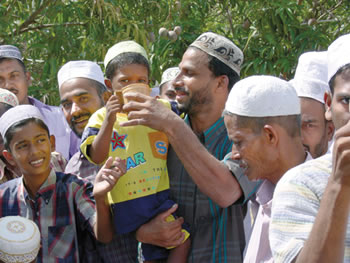
The local community can be thanked for some of these donations. In January 2005, Berkeley Lab Director Steve Chu issued a letter to the community that asked for contributions to help WaterHealth Inter-national ship the devices on a cost recovery basis, for about $10,000 per unit, to areas hit by the tsunami. This cost includes shipping, installing the device, training, and providing spare parts and maintenance for five years.
So far, 20 systems have been installed in Sri Lanka, and between four and five more systems are installed each week. These systems will be able to provide safe drinking water, often for the first time, to people displaced by the disaster. Ultimately, waterborne disease in tsunami-devastated areas will be reduced and the health of children and patients will be improved.
“All people are very thankful for this system. Other people came and left after the tsunami, but we feel confident that this system is here to stay,” says Mr. Mubarak, a resident of the Sri Lankan village of Kattankudi that was devastated by the tsunami.
In addition, WaterHealth Inter-national is installing three community water systems for tsunami relief in Tamil Nadu, India. These systems will be situated in shelters and temporary camps to meet the immediate needs of nearly 20,000 displaced people. When the emergency subsides, each system will be moved to a new settlement and upgraded to provide a sustainable, affordable supply of safe drinking water for communities as they are rebuilt.
Although these installations are supported by charitable donations, recent field tests prove that UV Waterworks is also economically sustainable. Last year, WaterHealth International installed two installations in Andra Pradesh, India. Once they were up and running, the systems were able to provide water at a cost of only 2 cents for 15 liters. In India, bottled water costs 25 cents per liter.
“We have shown that it is technically and financially feasible,” says Gadgil, who hopes that more systems can be installed as soon as possible. “I am impatient because the scale of the problem is enormous: 1.2 billion people worldwide do not have access to safe drinking water. Now, we have shown that we can provide it for a very small amount of money.”
Mission to Darfur: Researchers Bring Hope to the Sudan
Civil war in The Sudan has made the Darfur area into one of the largest refugee zones in the world. Although periodically in the news as tales of genocide, large-scale migration and clashes among rebels, rogue militias and government forces leak out, not many westerners can say what conditions really are like in these camps. Few Americans have actually visited Darfur.
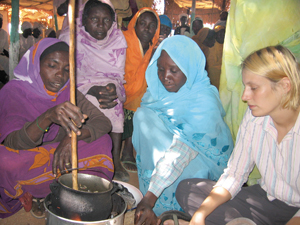 EETD�s Christina Galitsky observes cooking methods used by the women of Darfur.
EETD�s Christina Galitsky observes cooking methods used by the women of Darfur.
Two who have are Ashok Gadgil and Christina Galitsky of Berkeley Lab’s Environmental Energy Technologies Division. They went to Darfur, thanks to funding from CHF International, the U.S. Agency for International Development and private donors, to try to help solve one problem of the many facing the refugees. Women gathering firewood have to travel long distances unprotected outside camp boundaries, where they are subject to attack and rape by raiders. The countryside is so denuded of trees that they must travel farther and farther for the wood they need to cook their meals.
Knowing that many energy-efficient cookstoves exist built out of sheet metal from designs developed in India and other developing countries, Gadgil and Galitsky decided to test whether any of this technology could be adapted to the circumstances of Darfur, reducing, and perhaps eliminating the need for women to travel outside of camp. Cook stoves that use less wood, or alternative fuels such as animal dung, will also help the landscape recover in the long run.
The pair flew to Khartoum, and on to Nyala, southern Darfur, where they spent two weeks in November testing and demonstrating efficient cook stoves to the people of the Darfur refugee camps. Conditions there are very difficult, but not without hope.
On Thursday January 26 at noon, in the Building 50 auditorium, Gadgil and Galitsky will present a talk and slide show describing their experiences and what the prospects are for the future.
Science Roundup
A Selection of Recent Research Results from Berkeley Lab Scientists
The year’s soggy start didn’t slow the pace of discovery, as over the holidays Berkeley Lab scientists continued to report progress in fields ranging from forestry to quantum chemistry.
First detailed look at Dicer
 A segment of double-stranded RNA passes through the Dicer enzyme, which cleaves it into 25-nucleotide segments. (courtesy Doudna lab)
A segment of double-stranded RNA passes through the Dicer enzyme, which cleaves it into 25-nucleotide segments. (courtesy Doudna lab)
An enzyme named Dicer plays a crucial role in the process of RNA interference, producing short lengths of RNA that act like monkey wrenches in the genetic machinery. Part of a natural process that regulates genes and chromosomes, Dicer has lately gone commercial as a useful tool in genetic research, although until now its molecular structure has been unknown. Jennifer Doudna of Berkeley Lab’s Physical Biosciences Division and UC Berkeley led a team that used the Advanced Light Source to determine the structure of Dicer through x-ray crystallography. She says, “We’ve learned that Dicer serves as a molecular ruler, with a clamp at one end and a cleaver at the other end ... that produces RNA fragments of an ideal size for gene-silencing.” The report appeared in the 13 January 2006 issue of Science.
Two new computer clusters open for business
Bassi and Jacquard are the nicknames of two new NERSC computer clusters, opened for business January 9. In the 18th century physicist Laura Bassi was among the first to teach Newtonian “natural philosophy” in Italy; her experiments included installing the University of Bologna’s first lightning rod. Joseph Marie Jacquard invented the first programmable machines, mechanical looms, in 1801. Bassi’s namesake at NERSC is an IBM parallel computer with 888 processors that runs codes three to 10 times faster than NERSC’s older IBM supercomputer, Seaborg. Says Robert Duke of the University of North Carolina, “Both of these machines are really nothing short of fabulous ... Jacquard is perhaps the best performing commodity cluster I have seen. Bassi is the best machine I have seen, period.”
Study reveals new information about bones
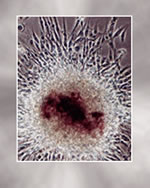 An osteoblast cell generates bone matrix in culture. (courtesy Derynck lab)
An osteoblast cell generates bone matrix in culture. (courtesy Derynck lab)
Bone gets its strength from the architecture and composition of the bone matrix, a mineral framework produced by cells known as osteoblasts. Robert Ritchie and Ravi Nalla of the Materials Sciences Division were part of a multi-institutional, multidisciplinary team led by Tamara Alliston of the University of California at San Francisco who determined that mechanical properties and mineral concentration of the bone matrix, as well as bone mass, are controlled by the ubiquitous growth-factor protein TGF-b. Their results, reported in the 27 December issue of Proceedings of the National Academy of Sciences, have implications for bone disease, bone’s ability to resist fracture and healing, and aging.
Blasting molecules to learn their secrets
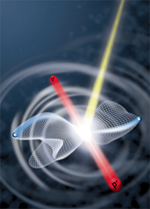 A hydrogen molecule hit by an energetic photon breaks apart into its constituent particles, two protons and two electrons. (courtesy Vanroose)
A hydrogen molecule hit by an energetic photon breaks apart into its constituent particles, two protons and two electrons. (courtesy Vanroose)
The position and momentum of electrons orbiting a molecule’s nucleus cannot be determined independently because, in the terminology of the trade, they are correlated. So it’s hard to determine just how a molecule’s electrons behave without blowing it to bits. That’s precisely the approach scientists working at the Advanced Light Source used to study electron correlation in the helium atom. Experiments in 2004 led by Thorsten Weber, then of the ALS, measured precisely what happens to a helium atom’s two protons and two electrons when it is struck by an energetic x-ray photon. The Chemistry Division’s Bill McCurdy, Thomas Rescigno, and then-postdoc Wim Vanroose, joined by Fernando Martín of the Universidad Autónoma de Madrid, provided the theoretical explanation and consequently solved, for the first time, the longstanding four-charged-particle problem of quantum mechanics. Their solution was published in the 16 December issue of Science.
Learning about sex from an elegant worm
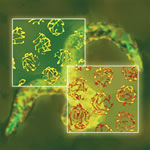 X chromosomes without Pairing Centers fail to join properly in the genetically altered C. elegans worm, (right); in wild-type C. elegans green fluorescing proteins signal successfully paired X chromosomes. (courtesy Dernburg)
X chromosomes without Pairing Centers fail to join properly in the genetically altered C. elegans worm, (right); in wild-type C. elegans green fluorescing proteins signal successfully paired X chromosomes. (courtesy Dernburg)
The nematode Caenorhabditis elegans is a millimeter long, completely transparent, and comes in two sexes, male and hermaphrodite (hermaphrodites are far more common), which makes it ideal for studying meiosis, the special form of cell division essential to sexual reproduction. Abby Dernburg of the Life Sciences Division, working with Needhi Bhala and many other collaborators, published two papers in the 16 December issue of Cell and a related paper in the 9 December issue of Science exploring the role of chromosomal sites called Pairing Centers, which occur at one end of the worm’s X chromosomes. Pairing Centers insure accurate exchange of genetic material and also function as quality-control checkpoints during cell division. While reproduction in C. elegans is quite different than in humans, the findings offer insight into human reproductive disorders.
Deep-rooted trees affect global climate
 The deep roots of trees in the Amazon forest carry surface water to reservoirs deep underground during the wet season, then pump it back up when hot, dry weather comes.
The deep roots of trees in the Amazon forest carry surface water to reservoirs deep underground during the wet season, then pump it back up when hot, dry weather comes.
Forests “transpire” — evaporate water to stay cool during hot seasons, like a person sweating to stay cool. But when researchers Jung-Eun Lee and Todd Dawson at UC Berkeley and Inez Fung of Berkeley Lab’s Earth Sciences Division noticed that the temperature of the Amazon rain forest dipped more than expected during dry seasons, they were led to a fascinating discovery: during the wet season the forest’s deep-rooted trees were sending surface water to reservoirs deep underground, then pumping this moisture back up during dry spells in order to keep the top layers of the forest moist. In the December 6 issue of the Proceedings of the National Academy of Sciences they report that the process also accentuates carbon uptake from the atmosphere, meaning forests are even more important in controlling global climate than previously understood.
The physics of traffic safety
“A certain level of carnage” is a price we’re willing to pay to drive how we want. Calling the present rate of traffic deaths appalling, Tom Wenzel of the Physics Division and two colleagues, Marc Ross and Deena Patel, of the University of Michigan at Ann Arbor, analyze vehicle design and the physics of traffic safety in the January, 2006 issue of Physics Today. Addressing the claim that lighter, more efficient cars are necessarily riskier, they present evidence that the problem isn’t lighter cars but the design of small trucks and SUVs. Even better than redesigning trucks for greater safety to their own occupants and others, the authors propose, would be simply replacing those vehicles used only as car substitutes with real passenger cars; doing so, they estimate, “would save three to four thousand lives a year,” 10 percent of all traffic fatalities.
In Memoriam
Former Lab Radiation DNA Chemist John L. Magee
 John L. Magee
John L. Magee
John L. Magee, a former Berkeley Lab scientist and member of the Manhattan Project, died on December 16, 2005, in Moraga, California, at age 91. During his career in radiation chemistry, he worked with Edward Teller, J. Robert Oppenheimer, Enrico Fermi, Hans Bethe and Richard Feynman. For 30 years he served on the faculty of the University of Notre Dame (1948-1978), where he was chair of the Chemistry Depart-ment, director of the Notre Dame Radiation Laboratory, and recipient of the Notre Dame Outstanding Faculty Award. Following his Notre Dame years, he joined Berkeley Lab as a senior staff scientist, where he worked in biomedicine until his retirement in 1986.
It was his work for the Manhattan Project, as a phenomenologist for the Trinity test, that would most deeply influence Magee’s later professional life. While he had misgivings about atomic weapons, he continued work on their technical aspects, convinced that continuing his scientific involvement and his direct work with the government in nuclear science was important “missionary work” within the military during the Cold War. He was on the staff for the Bikini test in 1946, and from 1946 to 1948 he was a group leader on opacity at Argonne National Laboratory. Up to 1965 he held various staff and consulting positions at the Pentagon with the Joint Chiefs of Staff (1955-57), at the Rand Corporation and at the Lockheed Palo Alto Laboratory.
Magee was an avid hiker and bicyclist, staying active into his later years. From 1980-90 he participated in the Strawberry Canyon 10K run in Berkeley, and also ran in the Lawrence Berkeley Lab Run-Around from 1980-96. Magee was a member of the American Chemical Society, the Radiation Research Society, of which he was President in 1967-68, the American Physical Society, the Royal Society of Chemistry, the American Association for the Advan-cement of Science, and the American Association of University Professors. He is survived by his wife of 58 years, Priscilla, and three children.
William Oswald, Earth Scientist, ‘Michael Jordan of Algae’
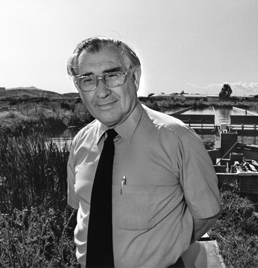 William Oswald
William Oswald
William Oswald, a scientist in Berkeley Lab’s Earth Sciences Division and Professor Emeritus of Environmental Engineering and Public Health at UC Berkeley, passed away at his home on Dec. 8, 2005. He was 86.
Oswald, who pioneered ways to use algae to address human problems, joined Berkeley Lab as a senior staff scientist in 2001. He is credited with developing the advanced wastewater pond systems technology in which wastewater passes through a series of ponds to be treated. These “high-rate ponds” use algae fermentation to produce oxygen, which purifies sewage.
Oswald built more than 100 wastewater treatment facilities around the world. Using his patented process the algae could be harvested as protein-rich food for animals or people. The leftover water, cleansed, could be used for irrigation, as a coolant for engines and even, with more purification, for human consumption. Sludge from the bottom of the pond could be added to the soil as humus, Oswald advised, while methane gas produced by the algae could be captured and used.
Treatment systems designed by Oswald are now in use in Bolivia, Brazil, Greece, Mexico and South Africa, as well as in the United States.
“William Oswald was a man ahead of his time. He developed and demonstrated sustainable technology decades before sustainability became a popular goal,” said Bailey Green, research scientist at Berkeley Lab. Green was a former Ph.D. student of Oswald’s in the Energy and Resources Group at UC Berkeley, and a close colleague of his for the past two decades. “Oswald was a humanitarian above all else,” Green said.
Oswald was particularly interested in developing a means for simple, affordable, sustainable wastewater treatment for developing countries. In recent years, he worked with the government of India to develop a way to use algae ponds to purify the Ganges River.
In a 1998 article on this Ganges effort, The New Yorker declared, “Oswald is to algae what Michael Jordan is to basketball.”
Oswald is survived by his wife, Eileen, and two sons.
People, Awards, and Honors
Barletta Off To �School,� Gourlay Named Acting Director of AFRD
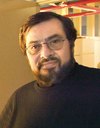 William Barletta
William Barletta
William Barletta, director of Berkeley Lab’s Accelerator and Fusion Research Division for the past 12 years, is departing to become Director of the U.S. Particle Accelerator School headquartered at Fermilab. Barletta, who directed the Lab’s preparation effort for the new University of California management contract, has headed AFRD for more than 12 years, during which time he developed and nurtured world-class efforts in diverse areas of accelerator physics. In a memo to AFRD staff, Director Steve Chu lauded Barletta for his leadership. “A key part of Bill’s legacy is the outstanding array of talented scientists who have been recruited into the Division,” Chu said. “This has positioned AFRD to make seminal contributions to accelerator science going into the future, and will continue to serve the Laboratory and the scientific community worldwide for years to come.” Chu also cited Barletta's role in developing programs in intelligence, non-proliferation and counter-terrorism, and praised him for his commitment to the duties of running a division.
“I have personally found how distracting administrative duties can be, and in fact about the only reward is to be able to look back and realize the real service you have provided to the welfare of the division and the Laboratory, as Bill has done,” said Chu.
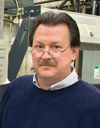 Steve Gourlay
Steve Gourlay
Steve Gourlay, head of Berkeley Lab’s Superconducting Magnet Program in the Accelerator and Fusion Research Division, has been named by Chu to serve as Acting Director of AFRD.
Gourlay, who has worked at the Lab since 1997 and been a senior staff scientist since 2002, has managed a vertically integrated effort to define and advance the cutting edge of superconducting magnet technology for accelerators. The Department of Energy Office of High Energy Physics has recognized AFRD’s program in superconducting magnet R&D as the world leader in developing high-field magnets for future accelerators.
As head of the Superconducting Magnet Group at Fermilab in 1995, Gourlay was in charge of a project to design a high gradient superconducting quadrupole for the Large Hadron Collider (LHC) interaction regions. A year later, he served a one-year appointment as a Scientific Associate at CERN as part of the US/CERN collaboration for the LHC. He now heads the magnet development component of the United States LHC Accelerator Research Program, a collaboration of three national labs — Berkeley, Brookhaven and Fermi.
UCOP’s Hatayama Takes Lead in EH&S
 Howard Hatayama
Howard Hatayama
Howard Hatayama is Berkeley Lab’s new Acting Division Director for Environment, Health and Safety. He has been Director of Environment, Safety and Health for the University of California Office of the President’s Laboratory Management Office. Hatayama accepted the assignment in December at Berkeley Lab Director Steve Chu’s invitation following the repositioning of Phyllis Pei to a safety advisor role in Chief Operating Officer David McGraw’s office.
Hatayama, who has served in his current capacity for the University since 1992, is responsible for administering health, safety, environmental restoration, and waste management aspects of the management contracts with Berkeley, Livermore and Los Alamos labs. He has played key roles in development and implementation of DOE ES&H programs, including line ES&H policy, Work Smart Standards, Integrated Safety Management, performance indicators and performance improvement measures.
Lab Nuclear Scientists Join Physical Society

 Left: Jacobs, Right: Thomas
Left: Jacobs, Right: Thomas
Two Berkeley Lab nuclear scientists have been named fellows of the American Physical Society. Both Peter Jacobs and James Thomas were honored for their work on the STAR detector at the Relativistic Heavy Ion Collider, or RHIC (located at Brookhaven Lab). Jacobs led the effort to study the suppression of high-momentum particles and jet quenching in relativistic heavy-ion collisions, while Thomas was involved with the construction and operation of the STAR detector at RHIC.
AFRD�s Gourlay Given Yearlong Lectureship

Steve Gourlay, acting director of the Lab’s Accelerator and Fusion Research Division, has been appointed the 2006 Distinguished Lecturer by the Institute of Electrical and Electronics Engineers. He will represent the institute’s Council on Superconductivity by presenting talks to universities and labs here and abroad throughout the year.
Reminder: Flea Market Now Online
To place an ad, visit the Flea Market website and click on the “Place an Ad” link. After input of an LDAP password, staff can submit their information using an electronic form. Images of sale items can also be included. Upon editorial approval, the ads will remain online for up to 30 days. Those who place ads can manage them after initial posting by logging into the website.
For more information about this new service, call x4698 or e-mail [email protected].
Management Initiative: Give Small Businesses a Chance
Ron Ball, manager of Berkeley Lab’s Small Business & Supplier Management Office, routinely travels to small business conferences throughout the U.S. to drum up interest in Berkeley Lab.
The goal of his road show is rooted in the new Department of Energy management contract with the University of California which calls for a substantial increase in the number of small business subcontracts at Berkeley Lab. His outreach efforts, aided by fellow Small Business & Supplier Management Office representative Sheri Freeman-Matterson, also extend to all Lab employees who are exploring subcontracting options.
“It is very important that end-users in the Lab make a good-faith effort to evaluate small businesses in their search for vendors,” says Ron Ball, who has worked at Berkeley Lab for 18 years and in procurement for 38 years.
 Ron Ball and Sheri Freeman-Matterson of Berkeley Lab’s Small Business Supplier Management Office.
Ron Ball and Sheri Freeman-Matterson of Berkeley Lab’s Small Business Supplier Management Office.
The Procurement Department’s Small Business Initiative stems from the Small Business Act, which mandates that government contractors utilize small businesses whenever possible. These include small disadvantaged businesses, women-owned small businesses, businesses in historically under-utilized urban or rural areas, veteran-owned and service-disabled owned business, and businesses with ties to historically black colleges and minority institutions.
The Lab has set the bar high. In fiscal year 2006, 41 percent of subcontracts must involve small businesses. That works out to $67 million of the total estimated value of all planned subcontracts, which is expected to be $162 million.
To help the Lab reach this goal, Ball and Freeman-Matterson arrange training for purchasing personnel regarding the intent and impact of the Small Business Initiative. Their wealth of knowledge, which focuses in part on local businesses, is derived from participating in events hosted by the Berkeley Chamber of Commerce, the Northern California Supplier Development Council, the Industry Council for Small Business Development, and The National Association of Women Business Owners. They also participate in the Minority Business Development Agency. In addition, they maintain a Small Business Office at the Lab’s procurement web site, found at http://purch1.lbl.gov/. And they keep an open-door policy to all suppliers.
“Berkeley Lab will provide small businesses the maximum practicable opportunity to participate in the performance of Lab subcontracts,” says Ball.
In many cases, choosing a small business isn’t a tough sell. The many advantages of using small businesses include lower costs (overhead costs are lower than most large businesses), flexibility (less bureaucracy), and improved service. As an added incentive, justification from the Procurement Department is now required for requisitions of more than $100,000 in which the recommended vendor is a large business. In addition, all requisitions more than $25,000 are reviewed to identify any subcontracting opportunities that might exist for small businesses.
Ball also cautions that the new management contract has an indemnification clause that states that if the Lab doesn’t meet its small business goals, and hasn’t demonstrated a good-faith effort to meet these goals, then the Department of Energy can withhold funding. Because of this, Ball asks that all potential purchasers keep small businesses in mind as they search for vendors.
“It is very important to work with Procurement staff early in your planning to identify small business opportunities,” says Ball. “Success of the Small Business Initiative rests with the entire Lab community.”
Berkeley Lab View
Published twice a month by the Communications Department for the employees and retirees of Berkeley Lab.
Reid Edwards, Public Affairs Department head
Ron Kolb, Communications Department head
EDITOR
Pamela Patterson, 486-4045,
[email protected]
Associate editor
Lyn Hunter, 486-4698
STAFF WRITERS
Lyn Hunter, 486-4698
Dan Krotz, 486-4019
Paul Preuss, 486-6249
Lynn Yarris, 486-5375
CONTRIBUTING WRITERS
Jon Bashor, 486-5849
Allan Chen, 486-4210
David Gilbert, (925) 296-5643
Photography
Roy Kaltschmidt, 486-5731
Creative Services Office
FLEA MARKET
486-5771, [email protected]
DESIGN
Caitlin Youngquist, 486-4020
Creative Services Office
Berkeley Lab
Communications Department
MS 65, One Cyclotron Road, Berkeley CA 94720
(510) 486-5771
Fax: (510) 486-6641
Berkeley Lab is managed by the University of California for the
U.S. Department of Energy.
Online Version
The full text and photographs of each edition of The View, as well as the Currents archive going back to 1994, are published online on the Berkeley Lab website under “Publications” in the A-Z Index. The site allows users to do searches of past articles.